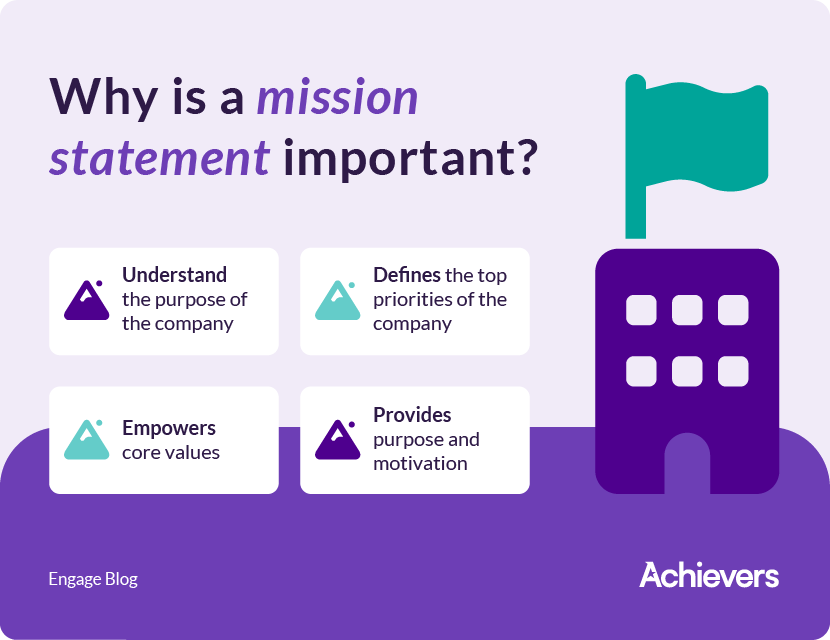Table of contents
There are many ways to define or approach a company mission statement, but the intent is the same in all cases: Mission statements are meant to align an organization’s employees to a clear, primary purpose. While many mission statements aren’t particularly inspiring, the most effective ones help employees find meaning in their work and feel like they’re making a difference for the greater good.
What is it about your company culture that defines your organization’s identity and builds your employee alignment? How do you tell the world about the values behind your company? A mission statement keeps everyone on the same page with respect to why you’re even in business at all. While you may feel that your primary purpose for existing is to be financially profitable, no company will achieve long-term success if its only mission is “to make money.” Larger goals matter, both for you and for your employees. Here’s an exploration of what mission statements are and are not, together with five characteristics that amazing company mission statements all have in common.
What is a company mission statement?
A mission statement is a short description that outlines a company’s business objectives, culture, and values. Usually in a sentence or two, it answers the what, how, and why of a company’s overall purpose, synthesizing important ideas to differentiate a business from their competitors. This is different from a personal mission statement which defines an individual, their values, and aspirations in life. In both cases, a mission statement encapsulates a company and individual’s essence while serving as a guide to help them achieve their goals.

Why is a mission statement important?
A mission statement is important because it helps different stakeholders understand the purpose and top priorities of a company. For employees, mission statements can empower company core values and cultures, motivating them to work with purpose and meaning and develop a long-term growth and commitment to their workplace. From a business’s standpoint, a clear and powerful mission statement can set a company apart from competition by emphasizing its competitive advantage. At any stage of your business, it is crucial to always circle back to your company mission statement and ensure your progress stays on track to success.
What is the difference between a vision statement and a mission statement?
A vision statement concisely expresses what a company wants to become and accomplish while a mission statement explains what the company does to achieve it. In simple words, the first one focuses on the future while the second one focuses on the present. A powerful vision statement needs a strong and clear mission statement. These two often go hand in hand and provide a high-level sense of direction for a company. For employees, a strong vision guides teams to work on what matters most for their company and promotes a purpose-driven business approach.
What are the characteristics of a good mission statement?
Mission statements are as varied as individual companies, but the really outstanding ones do have certain characteristics in common:
1. They are short and punchy
A mission statement shouldn’t be an essay. You’ll have better luck aligning your employees when they can remember what your mission statement is, instead of recalling it as a wall of words on a sign. Likewise, it should not be written in corporate jargon. Gee Ranasinha, CEO of marketing firm Kexino, puts it this way: “Mission statements need to be written using words and sentences that ‘normal’ people use and understand.”
A single sentence, aligned with the purpose of the company, can be more memorable than something elaborate and complex. For example, Tesla’s mission statement is to “accelerate the world’s transition to sustainable energy.” This is short, sweet, and to the point, clearly articulating the company’s goals in a consumable soundbite.
2. They start with an action verb
It’s helpful to read a few online lists of the very best mission statements. For instance, in this list you’ll notice that most of the statements have an action word at the beginning of the statement. After the word “to…” you see such words as “inspire,” “create,” “reinvent,” “give” and so on. Although there are variations in which some companies describe what they are going to “be” rather than what they’re going to “do,” the majority use very active phrasing.
Some great examples of this are: TED (“Discover and spread ideas that spark conversation, deepen understanding, and drive meaningful change”), LinkedIn (“connect the world’s professionals to make them more productive and successful”), and TikTok (“to inspire creativity and bring joy”).

3. They are specific
When your mission statement is clear and focused, it serves as a roadmap for everyone in your business. It tells your team exactly what you’re all about and what you’re aiming to achieve, making sure everyone is on the same page and moving in the same direction. This clarity not only builds trust and loyalty with your customers but also attracts employees who share your values and vision.
Here’s an example: “Deliver to customers and employees.” Would you be able to tell what kind of product this company is selling? Now, compare it to this: “To discover, develop and deliver innovative medicines that help patients prevail over serious diseases.” This statement, from Bristol-Myers Squibb Company, tells you precisely what the company does
4. They are directed both inside and outside
Ever stumbled upon a company’s mission statement that left you scratching your head, wondering who it was really talking to? You’re not alone. Crafting a mission statement isn’t just about ticking off a box — it’s about crafting a narrative that resonates both within and beyond the company walls.
Imagine reading a corporate mission statement solely fixated on shareholder value and ethical standards. Sure, it’s crucial for the company’s internal compass, but does it make you want to buy their products? Probably not.
So, let’s pivot to an example that satisfies both: Universal Health Services Inc. Their mission reads: “To provide superior quality healthcare services that patients recommend to family and friends, physicians prefer for their patients, purchasers select for their clients, employees are proud of, and investors seek for long-term returns.” This shows how a mission statement can satisfy both internal and external stakeholders, better shape perceptions, and build connections between different groups.
5. They are revisited every few years
Mission statements need to grow with the company. Regardless of how carefully you plan the path of your business, the passage of years will inevitably bring evolution. To keep your company’s mission statement relevant, it should be reevaluated every few years. While you may not need to rewrite it entirely, companies often find that it’s necessary to add something to a mission statement as they move forward with development.
Amazon is a great example of how corporate evolution can alter a mission statement. The ecommerce giant was originally an online book retailer with this as their mission statement: “to use the Internet to transform book buying into the fastest, easiest, and most enjoyable shopping experience possible.” However, as the company expanded into new areas, the mission statement needed to change. Its mission is now “to be Earth’s most customer-centric company, Earth’s best employer, and Earth’s safest place to work.” This shows how a company’s mission statement can — and should — evolve with the company.

How to write a mission statement
A clear and concise mission statement offers guidance and a sense of purpose for the company and everyone in it. When an organization is on the right track to achieve its goals, employee recognition is needed to embrace their hard work. This recognition fosters motivation, engagement, and loyalty, driving overall success and growth.
What are the steps to building a mission statement?
To build a mission statement, follow these steps:
- Identify your purpose: Define the fundamental reason your organization exists.
- Determine key values: List the principles and beliefs that guide your organization’s actions.
- Define the target audience: Identify who your organization serves or impacts.
- Outline your primary goals: Specify the main objectives your organization aims to achieve.
- Make it unique: Highlight what sets your organization apart from others in the industry.
- Be concise: Combine the core purpose, values, audience, goals, and unique aspects into a clear and concise statement.
- Get feedback: Seek feedback from stakeholders and refine the statement to ensure clarity and alignment with your organization’s vision.
- Be memorable: Make sure the final version is short, easily understood, and easy to recall.
- Be authentic: Ensure the mission statement accurately reflects the true essence and direction of your organization.
How long should a mission statement be?
A mission statement should be no more than one or two sentences or approximately 50 words. It should be brief, concise, and memorable to allow anyone to quickly grasp the core purpose and values of the organization.
What are the main elements of a mission statement?
The main elements of a mission statement are:
- Purpose: The fundamental reason the organization exists.
- Values: The core principles and beliefs that guide the organization’s actions and decisions.
- Audience: The specific group or community the organization serves or impacts.
- Goals: The main objectives or outcomes the organization aims to achieve.
- Uniqueness: The distinctive features or qualities that differentiate the organization from others.
Make your mission matter
Recognition, just like a sincere mission statement, helps improve employee loyalty, alignment, and belonging. By understanding the characteristics that make mission statements truly impactful, businesses can harness the power of their organizational identity to drive success. From specificity and clarity to authenticity and inspiration, these traits lay the foundation for a mission statement that resonates with both employees and customers alike.
Ultimately, a well-crafted mission statement isn’t just a statement — it’s a guiding force that shapes company culture, attracts top talent, and sets the stage for meaningful growth and impact. But none of this can be upheld if you don’t practice what you preach.
Take it up a notch by leveraging employee rewards and recognition platforms like the Achievers Employee Experience Platform™. These tools not only reinforce your commitment to appreciating employee contributions but also align individual efforts with organizational goals, boosting morale, engagement, and accountability. With Achievers, you’re investing in a product that is built to align with your company’s mission, driving sustainable success. Visit our website to learn more about our employee recognition software or request a demo today.
Key insights
- Discover what a mission statement is and why it's important to your company.
- Find 5 characteristics of amazing mission statements.
- Learn how to write a mission statement.



